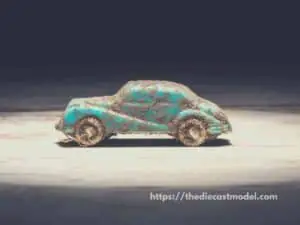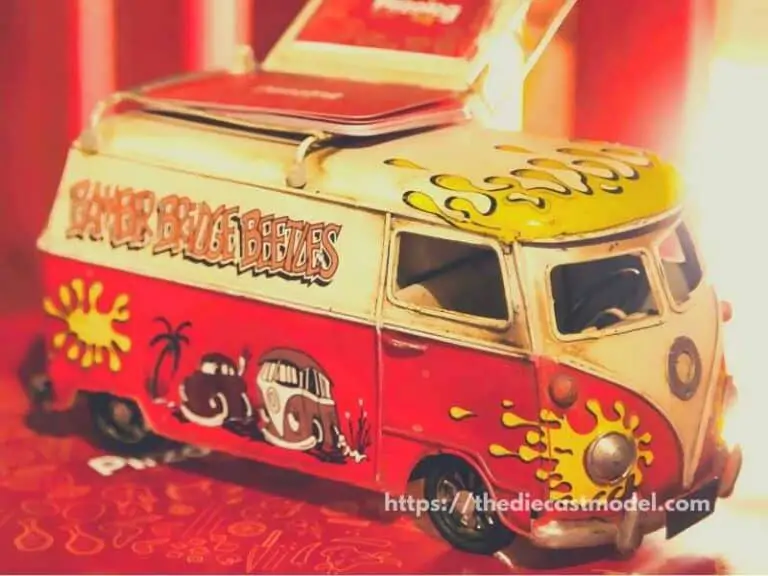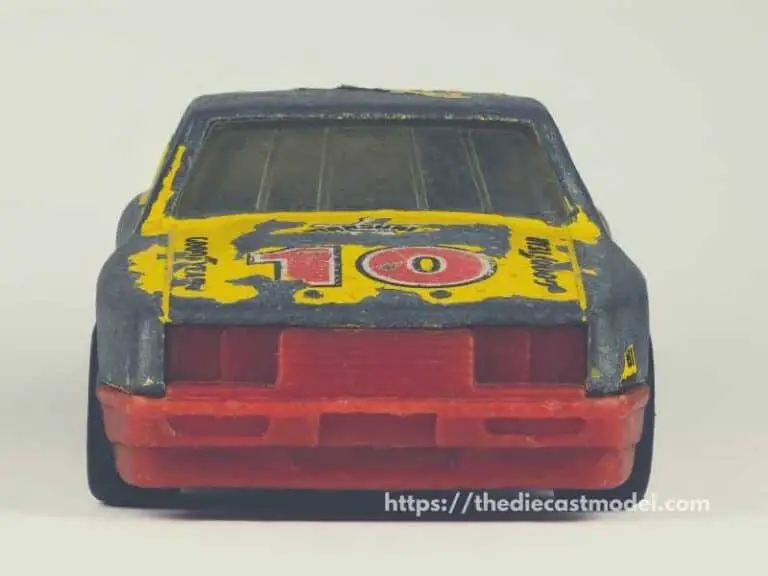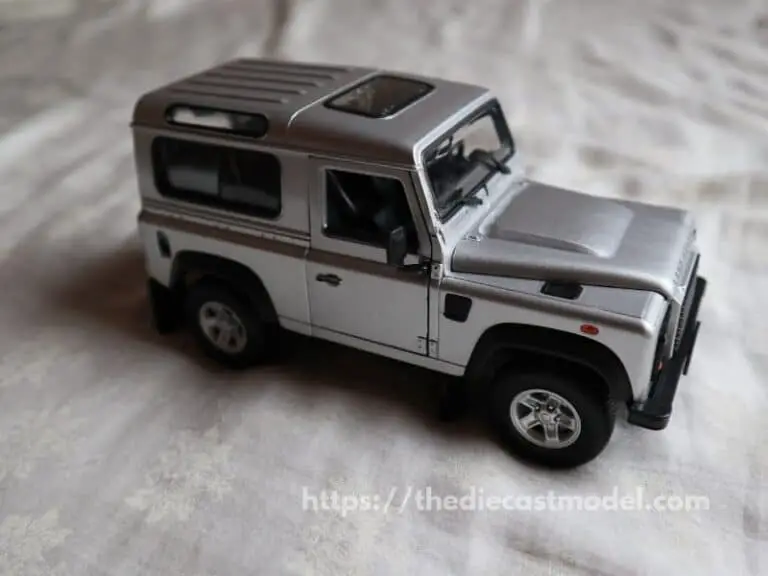Do Diecast Models Rust? How to Prevent it
In maintaining diecast models, one of the questions people always ask is if diecast models rust. That’s a common question since it is common knowledge that metals rust. Do diecast models really rust? If they rust, are there ways we can do to prevent it? Let’s find out.
Diecast models can rust. It hardly rusts because it is not made out of Iron. Diecast models are usually made from an alloy of Aluminum and Zinc which don’t rust. But if you don’t care for your models for long periods, there is a chance that they would rust.
In a natural setting, every iron-based metal is the makeup of a chemical that will inevitably succumb to rust, but because the problem is it is mostly preventable, this implies that your Diecast Models are not ruined! Your prized possession can continue in the best shape ever if you grasp how model rust, where the problem spots are, and how to handle the brown granular problems. This is what the article will be about.

Does Diecast Metal Rust?
Die casting is far more efficient, allowing for the rapid manufacturing of several copies of the same part. Also, compared to metal forging, die casting allows for far better definition and refinement of parts.
Diecast models can rust although, it hardly rusts except when soaked in water for over five months period at a stretch, It’s best not to over wash your diecast models and if you do, ensure you dried properly.
Because diecast is an alloy of numerous metals (zinc, aluminum, and magnesium, to name a few), it will not rust like ferrous metals (iron).
What Causes Diecast to Rust?
Whenever iron-based metals encounter electrochemical breakdown, rust is generated.
You’ll see a thin coating of rust on the surface of the iron with little absorption into the metal.
If you look at it closely. Exposed steel rusts at different rates based on the alloy components, density, climate, and type of heat treatment it receives.
To prevent your diecast from rusting right in front of you, a lot of experimentation and material science goes into its production.
Contemporary sheet steel has extremely durable coatings, such as anti-corrosion chemicals. Furthermore, alloying elements (like nickel and chromium) can assist prevent rust.
In short, diecast models are designed to last a long time and prevent rusting.
However, if the owner won’t take care of their models, then there might still be a chance for them to rust.
This is why, irrespective of where their model is stored or what kind of underbody coating it has, every model car owner should inspect their vehicle for rust on a regular basis.
I suggest you read my article on how to remove dust from your model since I have discussed multiple ways to clean your models there without any risk of rusting. Here is the link: How to remove dust from a model
What are some of the drawbacks of die casting?
While the process of diecasting prevents rusting, it still has some drawbacks.
Die casting’s drawbacks include:
- Metals and alloys with high melting points are not suitable (eg. steel)
- Large pieces are impossible to cast.
- Die costs are high.
- There is an excessively long lead period.
- Some gases could be trapped in porosity.
How To Prevent Diecast Models From Rusting
Intellectuals solve problems, geniuses prevent them.
– Albert Einstein
The easiest way to prevent diecast models from rusting is by applying some sort of wax to the surface. This prevents any form of oxidation to happen. Additionally, try to add a primer if you decide to repaint it. Lastly, do not wet the models as it can cause oxidation that can cause rust.
If you want to know the importance of a primer, then I suggest you read this other article I’ve made: Is Priming Models necessary before painting?
The Different Types of Rust and How to Get Rid of Them
Rust develops in stages, and understanding where a challenge is in the process of decomposition will help you find the proper solution. The three primary stages of rust, as well as how to treat them, are outlined below:
Rust on the surface
Paint nicks, cracks, and scratches are the earliest indicators of surface rust on your model diecast.
The tannic acid in the Permatex Rust Treatment reacts with the rust, converting it to iron tannate and 2-Butoxyethanol.
To stop the rust from spreading, you can use a rust inhibitor or converter. You could prime it if you can keep the surface dry for at least 24 hours. The Permatex Rust Treatment is neither paint nor clearcoat primer.
After allowing it to dry, you can allow it to blend the finishes. You can just let it dry if you’re in a place where no one can see you.
Rust on Scales
If you don’t address surface rust, cracks in your car’s paint may emerge.
The chemical process corrodes the metal’s surface and weakens it.
Scale removal entails using a wire brush to remove rust, a grinding wheel to remove roughness, and sandpaper to smooth off the surface.
Because body filler hardens quickly, NAPA suggests only mixing as often as you’ll need within ten minutes.
Rust that penetrates
Don’t take long for Bubbles to occur on the body of your model car if you live in a rust-prone area.
Check underneath and inside of the model car on a regular basis for any harsh or compromised sections that could provide a safety hazard if not repaired.
A rusted-through frame indicates that the diecast model’s structural stability is in doubt, and it should be evaluated and repaired by a professional service center.
Why Shouldn’t You Use Spray Paint to Cover Rust?
You should not use spray paint to cover rust because it only masks the problem. Leaving the rust underneath will just make the problem bigger in the future since rust can spread affecting other parts and surfaces. Over time, the rust will just spread inside leading to more problems.
Rust develops over time and can cause a slew of issues for metal objects and surfaces.
You might be able to cover up rust using spray paint, however, that doesn’t ensure the problem will disappear for good.
The more you delay treating rust on a metal surface, the more widespread it will get and the more your metal’s structural integrity will be jeopardized.
How to deal with rust before painting
Rust can be inconvenient, but it doesn’t have to keep you from spray painting a surface. Before you can begin spray painting, you’ll need to remove the corrosion and prepare the surface by following these steps:
Remove stains from the surface
To ensure that you can completely eliminate rust and prime your metal for painting, you must first clean it.
Before commencing the more rigorous procedure of cleaning rust, a basic solution of soap and water is usually adequate to remove dirt and grime.
Remove rust with a wire brush
Begin removing rust from the surface of your metal with a wire brush. Magica, a rust-removal solution, can help you get rid of corrosion quickly.
Brush down the metal after applying rust removal until you have a smooth and clean surface to work with.
Apply a rust-inhibitive primer
A rust-inhibitive primer will keep your metal looking and performing at its best for years to come. For the best results, follow the directions on the package when applying the primer.
Before you begin painting the metal surface, allow the primer to dry completely.
To prevent diecast models from rusting, mix the metal rescue concentrate with the water and pour it in. Then pour in a gallon of water, making sure it’s exactly a gallon and no more or less, and mix it up.
Soak the model a little and clean, ensuring that the interior and body are properly dried.
Conclusion
Nothing lasts forever and diecast collecting and maintaining can be hard, however, it doesn’t mean that taking care of it would expand its lifespan.
In fact, you can still see models from the 1960s that are well maintained.
Diecast models are rust-resistant. However, even if models have been proven to last for five months while submerged underwater, they still rust after that.
Many years ago Desiderius Erasmus said “Prevention is better than cure” and it’s still true today.
Follow the suggestions above to ensure you get the most out of your model diecast.

“Only the things I love”
thediecastmodel.com is reader-supported. When you buy through links on the site, I earn an affiliate commission.
So, here are the things I love when taking care of my Diecast Models.
Cleaning the Models
The first we are going to talk about is cleaning the models.
Removing Dust
- Air Brush – For me, this is the best since it not just removes dust but you can use it in painting/clear coating.
- Air Duster – This is a good alternative to Airbrush
- Normal Brush – If you are short on budget, you can use a normal brush. However, make sure that the brush has soft bristles because there are some hard brushes than can cause scratches. That’s why I recommended a good brush that can do the job properly.
Cleaning and Shining Hacks
Well, here are some of my cleaning hacks for removing scratches, oxidation, and so much more.
- Removing Decal Adhesive – Use Goo Gone on those hard-to-remove decal adhesives. It works fast and works like charm!
- Waxing and Polishing – Here is something a lot of people don’t know. Waxing protects the clear coat and paint while polishing shines the model. Instead of buying it separately, use a 2 in 1 to save money. Get this instead.
- Beginner Wax – The wax I recommended earlier is good and provides the best results based on my experience. But a beginner might have a problem especially if they’re not good at applying wax. Solid wax reaching hard to reach surface can be hard to remove. You have two choices here. One is to use a qtips to reach those surfaces, another is to use a liquid wax I recommended.
- Cleaning Wheels, Rubber, Plastic – Do not forget that rubber and plastic surface are quite different, especially in the cleaning process. Just wiping it down won’t do the job. That’s why I use Meguiar’s Vinyl and Rubber Cleaner and Conditioner. Works like charm!
- Make the Wheels Shine! – Making our models look good won’t be complete without tiny details such as shiny wheels! Do not forget this because however small this is, the difference can be as big as night and day.
- Remove Scratches Easily – Tiny scratches are not the end for your model. Here is a simple trick I’ve been using to make my models look scratch-free even without repainting. Use T-Cut.
Painting the Models
Painting Tools
Make sure when you paint models, have these ready.
- Tape – A tape is important if you are painting a straight line. Furthermore, it will prevent your paint to scatter on other parts. I recommend Tamiya Tape since it is really made for models. Furthermore, they stick really well preventing paint splatters.
- Brush (Beginner) – Find a good set of brushes to paint your models. Of course, you can opt for an airbrush but it’s quite expensive.
- Airbrush (Intermediate/Expert) – This will yield a significantly better result than an ordinary brush because you can easily spray the paint evenly. I recommend this if you know what you’re doing.
- Stand(Optional) – Stands are good because it can be hard to manually hold the models while painting. It is optional but in my opinion, the price is well worth it for the comfort it gives.
- Drop Cloths – Drop Cloths will protect your surroundings from the paint.
- Primer – The most common beginner mistake I see is painting models without any Primer. A primer will prevent imperfections such as bubbles or paint not sticking to your models. It is a small price to pay for quality results.
- Clear Coat – A clear coat will protect the paint of your models. This will make the paint last longer. Also, it is the one responsible for making your models shine.
Paints
Of course, you can’t do painting properly without paint. So here are the ones I recommend.
- Acrylic Paint – Good for beginners because it dries quickly. However, it doesn’t produce results as good as enamel paint.
- Enamel Paint – Provides a good quality finish and longer-lasting paint. However, it takes longer to dry and requires expertise to use.
Model Maintenance
Model Storage
- Simple Wood Cabinet – While it doesn’t let you display your models, wooden cabinets are good storage for these models. For one, they are not heat conductors which means that the temperature inside will remain constant and remain cool. Furthermore, they prevent light from reaching the models which can cause oxidation.
- Clear Cabinet with Lock – If you want to display your models, then I recommend this. It closes so dust won’t easily get to your models. I also recommend you don’t put more than 1 model in each compartment since metals are good conductors of heat.
Model Photography
So you want to show off your models to others? Well, I got you covered.
Here is my beginner-friendly model photography tutorial that teaches everything from taking pictures to the editing process.
You will also see me doing hands-on photography in that tutorial.
Here is the link: How to Take Pictures of a Diecast Model or Model Kit | Helpful Illustrated and Video Guide







